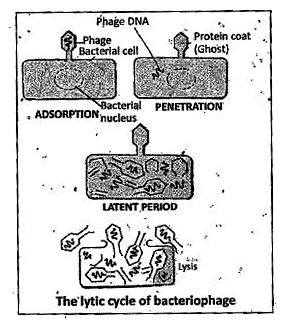Explain the lytic cycle with reference to certain viruses . Solution in Telugu
T- even phages that attack the bacterium E coli cause lysis of the cells and are called virulent phages. They show lytic cycle. It involves, 5 step process. They are 1. attachment 2. penetration 3. biosynthesis 4. maturation and 5. release.
1. Attachment:
1) Contact of the virion to the surface of host bacterium is called attachment or adsorption.
2) The phages. use tail fibres for .attachment to the complementary receptor sites on the bacterial cell wall.
2. Penetration :
1) The injection of phage nucleic acid into the host cell is called penetration.
2) The phage DNA is injected into the bacterium through the tail core like a hypodermal syringe.
3) The capsid remains outside the bacterial cell and is . referred to as ghost.
3. Biosynthesis :
1) Once the phage DNA reaches the cytoplasm of the host cell, many copies of phage DNA, enzymes and capsid proteins are synthesized, using the cellular machinery of .the host cell.
2) Host cell do not contain any complete infective viruses.
4. Maturation:
1) In this process bacteriophage DNA and capsids are .assembled into complete virions.
2) This period of time between the infection by a virus and the appearance of the mature virus within the cell is called the eclipse period.

5. Release :
1) The final stage of viral multiplication is the lysis phase of the host cell and the release of virions from the host cell.
2) The plasma membrane of the host cell gets dissolved or lysed due to viral enzyme called lysozyme.
3) The bacterial cell wall breaks releasing the newly produced phage particles/virions.
Topper's Solved these Questions
- MODEL PAPER 2BOOK - VGS PUBLICATION-BRILLIANTCHAPTER - MODEL PAPER 2EXERCISE - SECTION - C
6 Videos
- MODEL PAPER 2BOOK - VGS PUBLICATION-BRILLIANTCHAPTER - MODEL PAPER 2EXERCISE - SECTION - C
6 Videos
- MODEL PAPER 12BOOK - VGS PUBLICATION-BRILLIANTCHAPTER - MODEL PAPER 12EXERCISE - SECTION-C
3 Videos
- MODEL PAPER 3BOOK - VGS PUBLICATION-BRILLIANTCHAPTER - MODEL PAPER 3EXERCISE - SECTION - C
3 Videos
Similar Questions
Explain the reactions of Kreb's cycle.
View SolutionExplain the reactions of Kreb's cycle.
View SolutionDescribe the structure of the heart of a man. Draw a neat labelled diagram of it.
View SolutionGive an account of glycolysis, Where does it occur ? What are the end products? Trace the fate of these products in both aerobic, and anaerobic respiration.
View Solutionविषाणुओं में लाइटिक चक्र विधि द्वारा जीन प्रकटन को संक्षेप में समझाइए।
View Solutionलाइटिक चक्र पर टिपण्णी लिखिए।
View Solutionविषाणुओं में लाइटिक चक्र विधि द्वारा प्रकटन को संक्षेप में समझाइए।
View SolutionWhat is the correct sequence of the stages in bacteriophage lytic cycle ?
View SolutionSketch and label lytic cycle.
View SolutionWhat is the correct sequence of the stages in bacteriophage lytic cycle?
View SolutionGive a concise account on virulent cycle (or) Explain Lytic cycle of a phage.
View SolutionBriefly describe lytic and lysogneic cycle with cyclic diagram.
View SolutionIdentify the correct sequence regarding lytic cycle of viruses.
(A) Penetration (B) Adsorption (C) Assembly (D) Synthesis
View SolutionIdentify the correct sequence regarding lytic cycle of viruses. (A) Penetration (B) Adsorption (C) Assembly (D) Synthesis
View SolutionSequencely mention the types of lytic cycle.
View SolutionHow lytic cycle differs from lysogenic cycle ?
View Solution
